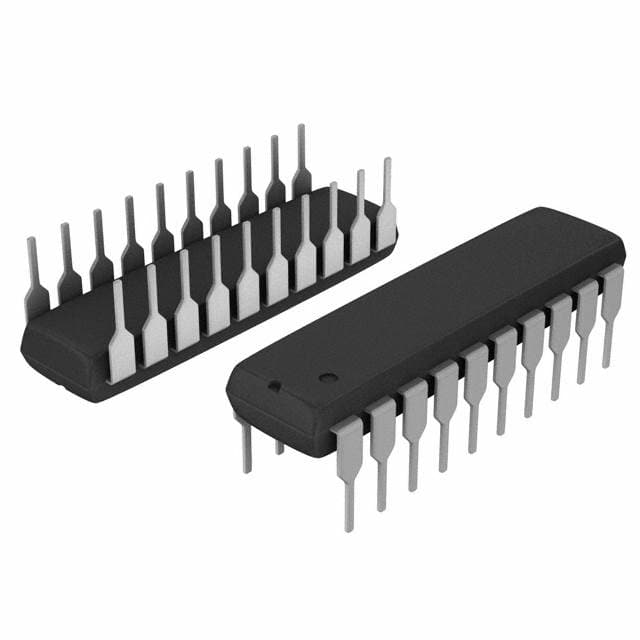Consulte las especificaciones para obtener detalles del producto.

Encyclopedia Entry: 74ACT245PC
Product Overview
Category
The 74ACT245PC belongs to the category of integrated circuits (ICs) and specifically falls under the family of octal bus transceivers.
Use
This IC is primarily used for bidirectional data transfer between two buses. It enables the transmission of data from one bus to another, allowing seamless communication between different parts of a digital system.
Characteristics
- Octal (8-bit) bus transceiver
- Bidirectional data transfer capability
- High-speed operation
- Compatible with TTL logic levels
- Low power consumption
- Wide operating voltage range
Package
The 74ACT245PC is available in a 20-pin plastic dual in-line package (DIP). This package provides physical protection and facilitates easy integration into electronic circuits.
Essence
The essence of the 74ACT245PC lies in its ability to facilitate efficient and reliable data transfer between two buses within a digital system. It acts as a bridge, ensuring smooth communication and synchronization of data.
Packaging/Quantity
The 74ACT245PC is typically packaged in tubes or trays, containing multiple units per package. The exact quantity may vary depending on the manufacturer and supplier.
Specifications
- Supply Voltage Range: 4.5V to 5.5V
- Input Voltage Range: 0V to VCC
- Output Voltage Range: 0V to VCC
- Operating Temperature Range: -40°C to +85°C
- Maximum Propagation Delay: 6 ns
- Maximum Output Current: ±24 mA
Detailed Pin Configuration
The 74ACT245PC features a total of 20 pins, each serving a specific function. The pin configuration is as follows:
- OE (Output Enable) - Output control pin
- A1-A8 (Input/Output) - Bidirectional data bus pins
- B1-B8 (Input/Output) - Bidirectional data bus pins
- GND (Ground) - Ground reference pin
- B8 (Input/Output) - Bidirectional data bus pin
- B7 (Input/Output) - Bidirectional data bus pin
- B6 (Input/Output) - Bidirectional data bus pin
- B5 (Input/Output) - Bidirectional data bus pin
- B4 (Input/Output) - Bidirectional data bus pin
- B3 (Input/Output) - Bidirectional data bus pin
- B2 (Input/Output) - Bidirectional data bus pin
- B1 (Input/Output) - Bidirectional data bus pin
- A8 (Input/Output) - Bidirectional data bus pin
- A7 (Input/Output) - Bidirectional data bus pin
- A6 (Input/Output) - Bidirectional data bus pin
- A5 (Input/Output) - Bidirectional data bus pin
- A4 (Input/Output) - Bidirectional data bus pin
- A3 (Input/Output) - Bidirectional data bus pin
- A2 (Input/Output) - Bidirectional data bus pin
- VCC (Supply Voltage) - Power supply pin
Functional Features
- Bidirectional data transfer between two buses
- Output enable control for tri-state operation
- TTL-compatible inputs and outputs
- High-speed operation for efficient data transmission
- Low power consumption for energy efficiency
- Wide operating voltage range for compatibility with various systems
Advantages and Disadvantages
Advantages
- Enables seamless communication between different parts of a digital system
- Supports bidirectional data transfer, enhancing system flexibility
- High-speed operation ensures efficient data transmission
- Low power consumption contributes to energy efficiency
Disadvantages
- Limited to 8-bit data transfer, may not be suitable for larger data sizes
- Requires careful consideration of bus synchronization to avoid data corruption
Working Principles
The 74ACT245PC operates based on the principles of tri-state logic. It allows bidirectional data transfer by enabling or disabling the output drivers using the Output Enable (OE) pin. When OE is high, the outputs are in a high-impedance state, effectively disconnecting the IC from the buses. This tri-state functionality prevents bus contention and enables multiple devices to share the same bus without interference.
Detailed Application Field Plans
The 74ACT245PC finds applications in various digital systems where bidirectional data transfer between buses is required. Some common application fields include:
- Microprocessor-based systems
- Data communication equipment
- Industrial automation systems
- Embedded systems
- Automotive electronics
- Consumer electronics
Detailed and Complete Alternative Models
There are several alternative models available that offer similar functionality to the 74ACT245PC. Some notable
Enumere 10 preguntas y respuestas comunes relacionadas con la aplicación de 74ACT245PC en soluciones técnicas
Sure! Here are 10 common questions and answers related to the application of 74ACT245PC in technical solutions:
Q: What is the 74ACT245PC? A: The 74ACT245PC is an octal bus transceiver with 3-state outputs, commonly used for bidirectional data transfer between different voltage levels.
Q: What is the maximum operating voltage for the 74ACT245PC? A: The maximum operating voltage for the 74ACT245PC is typically 5.5 volts.
Q: Can the 74ACT245PC be used for level shifting between different voltage domains? A: Yes, the 74ACT245PC can be used for level shifting between different voltage domains, as it supports bidirectional data transfer.
Q: How many data lines can the 74ACT245PC handle? A: The 74ACT245PC can handle up to 8 data lines, as it is an octal (8-bit) bus transceiver.
Q: What is the purpose of the 3-state outputs in the 74ACT245PC? A: The 3-state outputs allow the device to be effectively disconnected from the bus, enabling multiple devices to share the same bus without interfering with each other.
Q: What is the typical propagation delay of the 74ACT245PC? A: The typical propagation delay of the 74ACT245PC is around 6 nanoseconds.
Q: Can the 74ACT245PC be used in high-speed applications? A: Yes, the 74ACT245PC is designed for high-speed operation and can be used in applications where fast data transfer is required.
Q: Does the 74ACT245PC have any built-in protection features? A: Yes, the 74ACT245PC has built-in diode clamps on the inputs and outputs to protect against electrostatic discharge (ESD) events.
Q: Can the 74ACT245PC be used in both parallel and serial communication systems? A: Yes, the 74ACT245PC can be used in both parallel and serial communication systems, as it supports bidirectional data transfer.
Q: Are there any specific considerations for power supply decoupling when using the 74ACT245PC? A: Yes, it is recommended to provide proper power supply decoupling capacitors near the VCC and GND pins of the 74ACT245PC to ensure stable operation and minimize noise.

